Diversity at OU
1959: First OU "For Credit" Classes
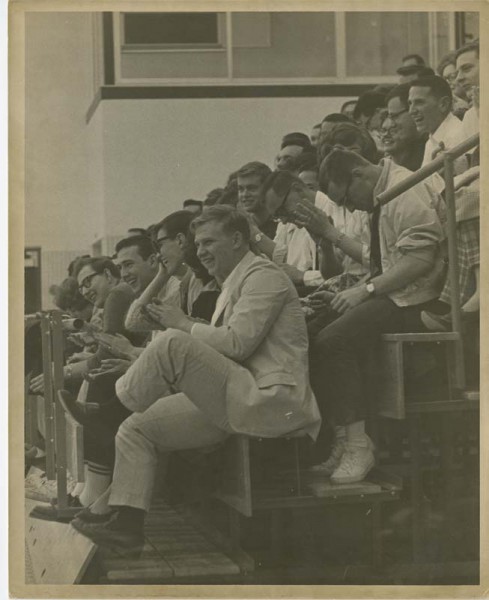 First "for credit" classes begin on September 21 with 570 students (1). Race and gender statistics are unavailable for this group.
First "for credit" classes begin on September 21 with 570 students (1). Race and gender statistics are unavailable for this group.
Image: Oakland University Archives
1. In July 1958, OU offers non-credit continuous education class in a converted chicken coop. See OU Firsts
1959: Lynn Anderson Ruth: First OU Student
 Chosen from a pool of students who finished in the top half of their class, Lynn Anderson Ruth registers for classes at Michigan State University - Oakland and receives student number 000001, making history as the first MSUO student.
Chosen from a pool of students who finished in the top half of their class, Lynn Anderson Ruth registers for classes at Michigan State University - Oakland and receives student number 000001, making history as the first MSUO student.
Image: Oakland University Archives
1959: OU's First International Students

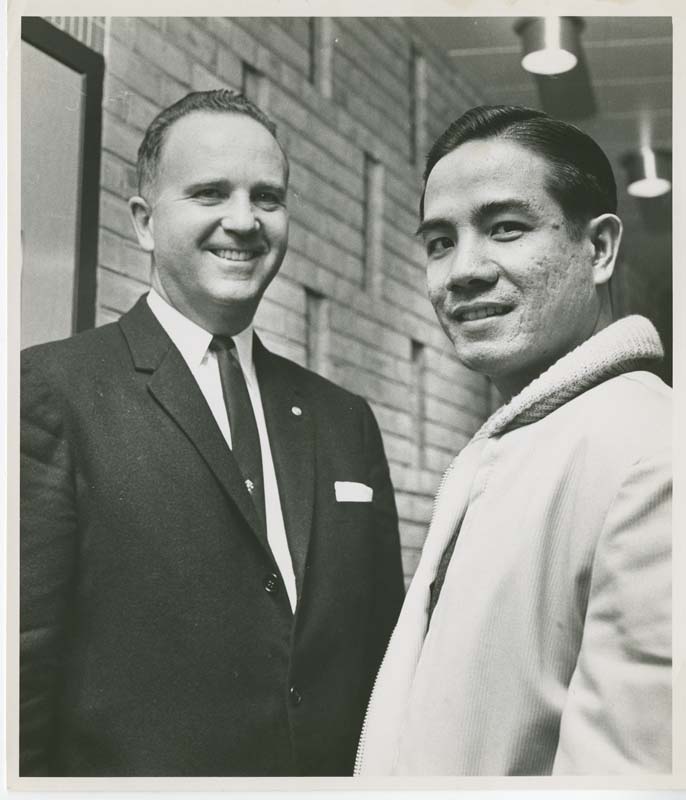 OU enrolls its first international student, Aydin Ilgaz, a 19-year old male from Istanbul, Turkey (1). Dang Xich Lan (above right), a 29 year old from Vietnam, enrolls in January 1960 (2).
OU enrolls its first international student, Aydin Ilgaz, a 19-year old male from Istanbul, Turkey (1). Dang Xich Lan (above right), a 29 year old from Vietnam, enrolls in January 1960 (2).
1. "MSU-O Has First Foreign Student," The Oakland Observer, 11 December 1959, p. 5.
2. "Vietnam Student Enrolls at MSUO," The Oakland Observer, 29 January 1960, p. 1.
Images: Oakland University Archives
1960: Association of Women Students
 Image: Oakland University Archives
Image: Oakland University Archives
The University forms an on-campus organization for women students: the Association of Women Students (1). This association is briefly mentioned in the October 14, 1960 Academic Senate meeting minutes.
1. Oakland Observer, Oct. 21, 1960, p.3, v.2: no.2.
1962: Associated Women Students of Michigan State University Oakland
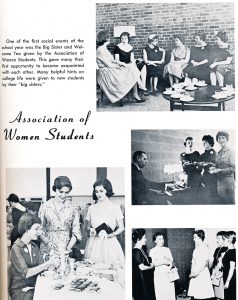
Image source: 1961 Student Yearbook "Oak Leaves"
Students formed the Associated Women Students of Michigan State University Oakland. The group aimed to "provide a spirit of unity among women students to promote high standards academically and socially, to represent women students in matters of university interest, to work cooperatively with faculty, students, and other organizations toward the continued development of the university, and to help develop qualities of leadership and responsibility among women students." All women students at OU would be members of the association. There would be no membership dues and the organization would operate on the University activities budget. By April of 1962, the Associated Women Students were a part of the Intercollegiate Association of Women Students. Some members of the organization were even able to travel across the state to an IAWS conference to meet other similar organizations.1962: First OU Enrollment Statistics by Gender
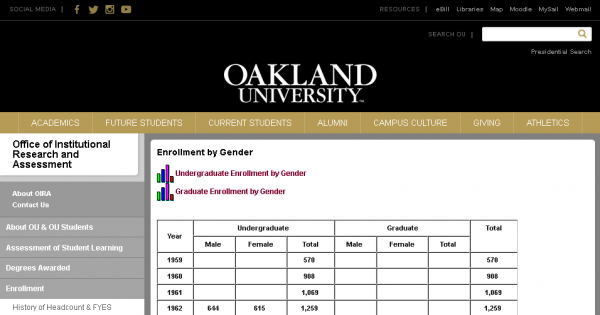 OU starts reporting student enrollment by gender. According to the Office of Institutional Research and Assessment, a total of 1, 259 students enrolled in the Fall 1962 semester: 615 women and 644 men.
OU starts reporting student enrollment by gender. According to the Office of Institutional Research and Assessment, a total of 1, 259 students enrolled in the Fall 1962 semester: 615 women and 644 men.
Image: "Enrollment by Gender", Office of Institutional Research and Assessment
1965: Diversity and Inclusiveness Leadership: Dr. Manuel H. Pierson
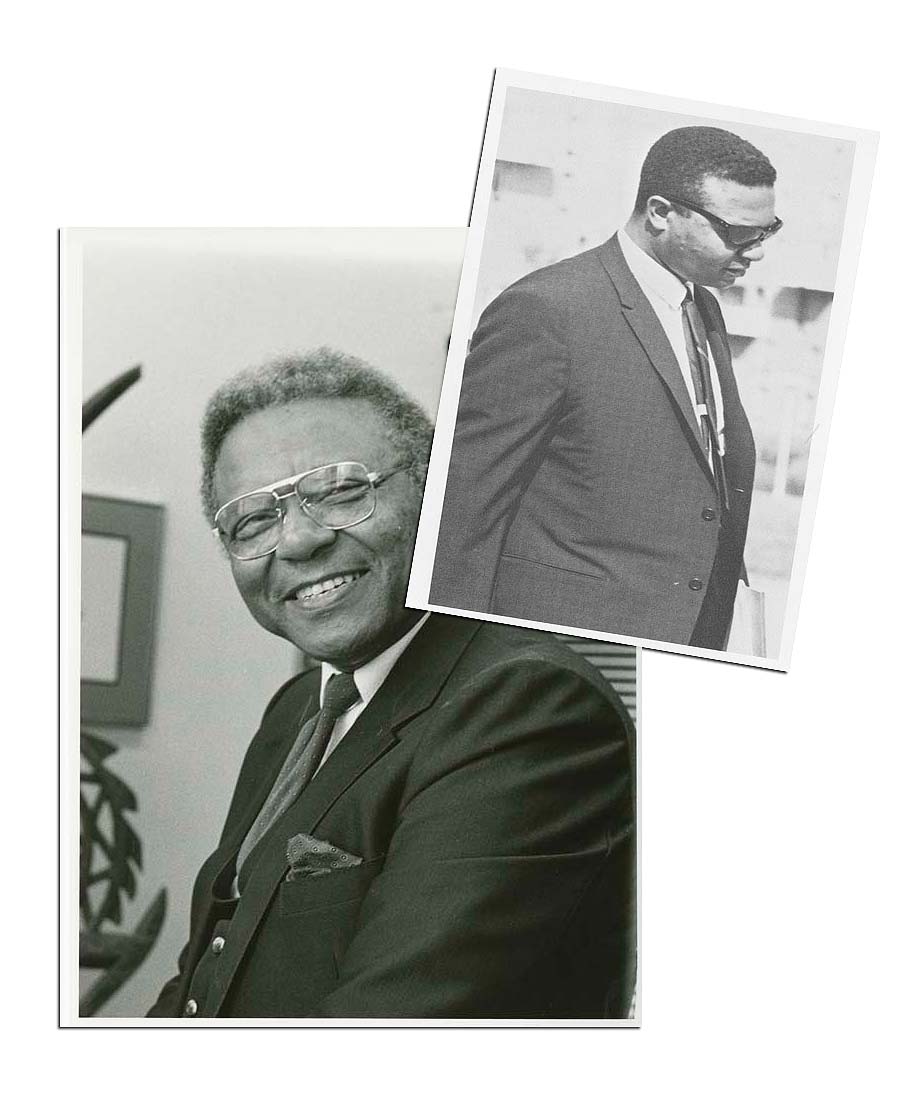
A founding father of OU diversity efforts, Dr. Manuel H. Pierson begins a 28 year mission to promote diversity and equal opportunity for students, staff, and faculty. During his tenures as Associate Dean of Students and Director of Special Projects, Associate Dean of Student Services, and Assistant Vice President, Dr. Pierson leads many diversity and equal opportunity initiatives, including Upward Bound and Project 20.
Dr. Pierson dies on February 13, 2006. The University holds a memorial on March 16th. His colleagues and friends recall his achievements during the 14th Annual Keeper of the Dream Banquet at OU. Dr Pierson's pioneering spirit lives on in Oakland's continuing mission of diversity and inclusiveness.
Image: Oakland University Archives
1965: First OU African American graduate
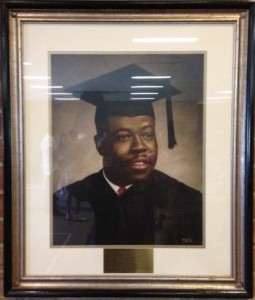 Isaac Jones is the first African American graduate at OU. He received a BA in Sociology.
In 1968, Jones is fatally shot. OU creates a scholarship in his name (see Chancellor Varner's speech for dignity and justice for all and 1968 Isaac Jones Memorial Scholarship entry below).
Image: Photo of Isaac Jones portrait in Oakland Center. Photographer: Johnnie R. Blunt
Isaac Jones is the first African American graduate at OU. He received a BA in Sociology.
In 1968, Jones is fatally shot. OU creates a scholarship in his name (see Chancellor Varner's speech for dignity and justice for all and 1968 Isaac Jones Memorial Scholarship entry below).
Image: Photo of Isaac Jones portrait in Oakland Center. Photographer: Johnnie R. Blunt
1965: Pontiac-Oakland Education Assistant Team
Students create POEAT - the Pontiac-Oakland Education Assistant Team - , a project to pair volunteer students with Pontiac school children. 4th, 5th and 6th grade students from Pontiac schools are brought to campus for days of cultural and recreational activities.1966: Project Upward Bound
 Project Upward Bound is founded. A federally funded program, it serves underachieving high school students who have the potential for post high school training. Its mission is to provide academic, social, cultural, and career enrichment that prepares students to succeed in higher education.
Project Upward Bound is founded. A federally funded program, it serves underachieving high school students who have the potential for post high school training. Its mission is to provide academic, social, cultural, and career enrichment that prepares students to succeed in higher education.
1967: Project 20
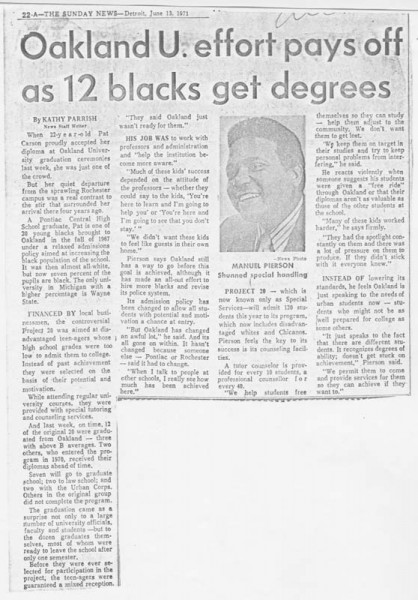 In an effort to create a more ethnically diverse student population, OU admits 20 African American high school graduates under the Project 20 initiative. Funded by local businesses, Project 20 "aim[s] at disadvantaged teenagers whose high school grades [are] too low to admit them to college. Instead of past achievement they [are] selected on the basis of their potential and motivation". In June 1971, twelve Project 20 students graduate from OU (1).
1. The Sunday News-Detroit, June 13, 1971 p. 22A
Image: Oakland University Archives
In an effort to create a more ethnically diverse student population, OU admits 20 African American high school graduates under the Project 20 initiative. Funded by local businesses, Project 20 "aim[s] at disadvantaged teenagers whose high school grades [are] too low to admit them to college. Instead of past achievement they [are] selected on the basis of their potential and motivation". In June 1971, twelve Project 20 students graduate from OU (1).
1. The Sunday News-Detroit, June 13, 1971 p. 22A
Image: Oakland University Archives
1968: Association of Black Students
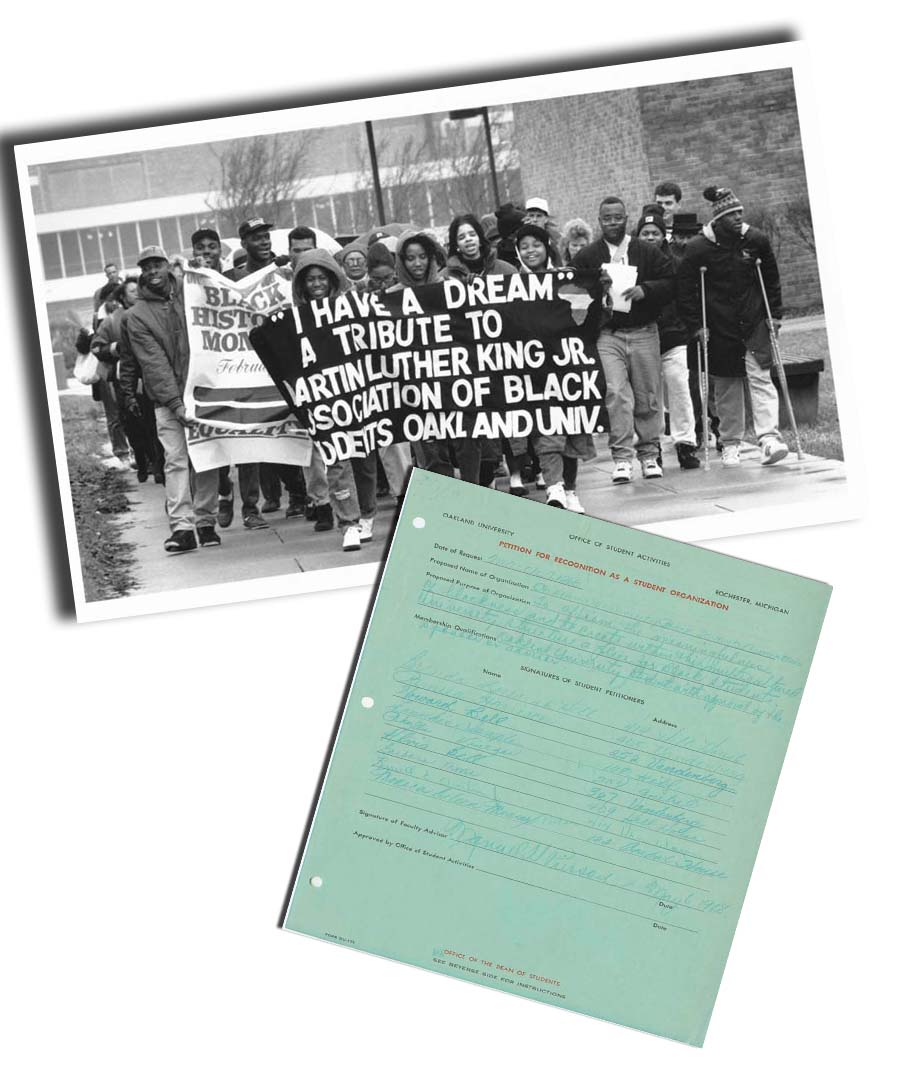 According to a historical survey of Oakland University student organizations from 1959 to 1980, the Association of Black Students was founded in summer 1968 (1). From 1971 to 1973, the organization was renamed Black Liberation Caucus (See 1971 entry for Black Liberation Caucus). Above left: ABS members celebrate Black History Month. Above Right: copy of 1968 petition for recognition as a student organization, signed by initial faculty advisor--Manuel H. Pierson.
1. Waddell, H. (1980). Student Organizations at Oakland University 1959-1980. p.57.
Image: Oakland University Archives
According to a historical survey of Oakland University student organizations from 1959 to 1980, the Association of Black Students was founded in summer 1968 (1). From 1971 to 1973, the organization was renamed Black Liberation Caucus (See 1971 entry for Black Liberation Caucus). Above left: ABS members celebrate Black History Month. Above Right: copy of 1968 petition for recognition as a student organization, signed by initial faculty advisor--Manuel H. Pierson.
1. Waddell, H. (1980). Student Organizations at Oakland University 1959-1980. p.57.
Image: Oakland University Archives
1968: First OU Woman Engineer
Ann Auten, a native of Athens, Michigan, is the first female graduate from the OU School of Engineering (1).1.Lakeland Tribune, August 8, 1968
1968: Isaac Jones Memorial Scholarship
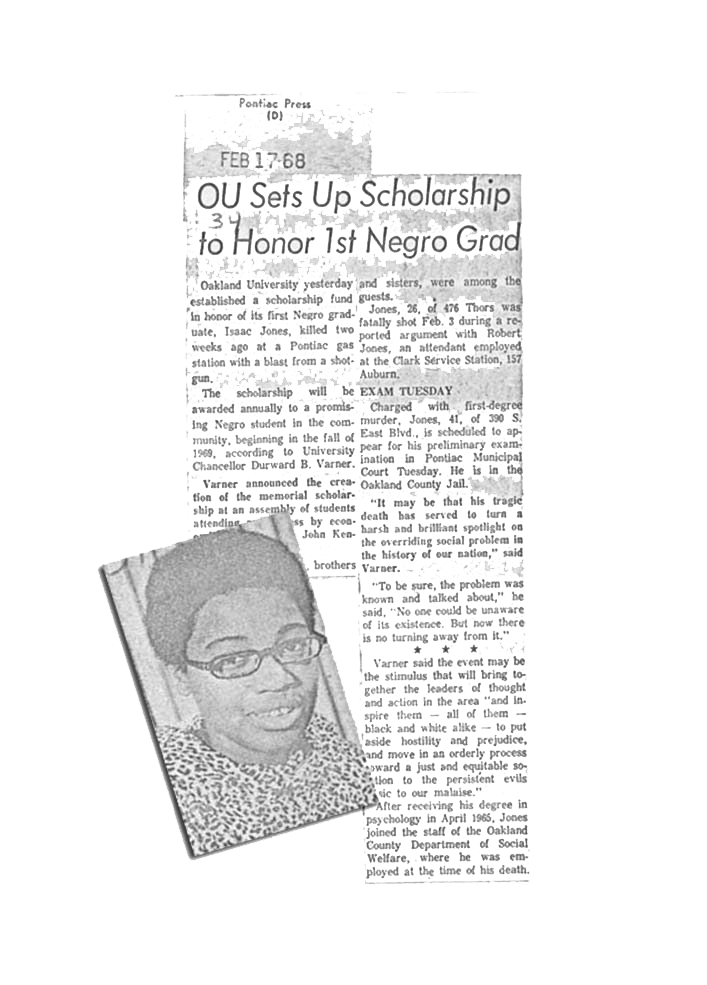 Shortly after the February 3rd murder of Isaac Jones, OU's first African American graduate, the University establishes the Isaac Jones Memorial Scholarship fund. The financial aid gift is awarded to promising African American high school graduates from Pontiac, Michigan. Pontiac Central High graduate Cecilia E. Brown (picture above) is the first recipient.
Image: Oakland University Archives
Shortly after the February 3rd murder of Isaac Jones, OU's first African American graduate, the University establishes the Isaac Jones Memorial Scholarship fund. The financial aid gift is awarded to promising African American high school graduates from Pontiac, Michigan. Pontiac Central High graduate Cecilia E. Brown (picture above) is the first recipient.
Image: Oakland University Archives
1968: Urban Affairs Center
The Urban Affairs Center is established, directed by a new assistant chancellor for urban affairs.1969: Ad Hoc Committee on women's rights
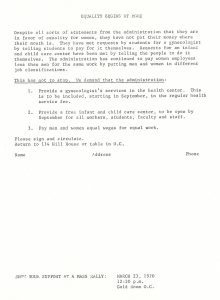
Document source: Women's Rights, Ad Hoc Committee, 1969, vertical file, Oakland University Archives
In 1969, Oakland female faculty created an Ad Hoc Committee to discuss women's rights on campus. Some of the key points they brought up were the need for a university subsidized child care center, gynecological services in the health center, and equal wages for equal work. A survey was completed in December of 1969, revealing statistics about the university population. Out of 301 faculty, only 49 of them were female, and out of 64 marked as professors, only two of them were female. In addition, while 39% of male faculty members were tenured, only 10% of female faculty were.1969: First OU African-American Celebration Month
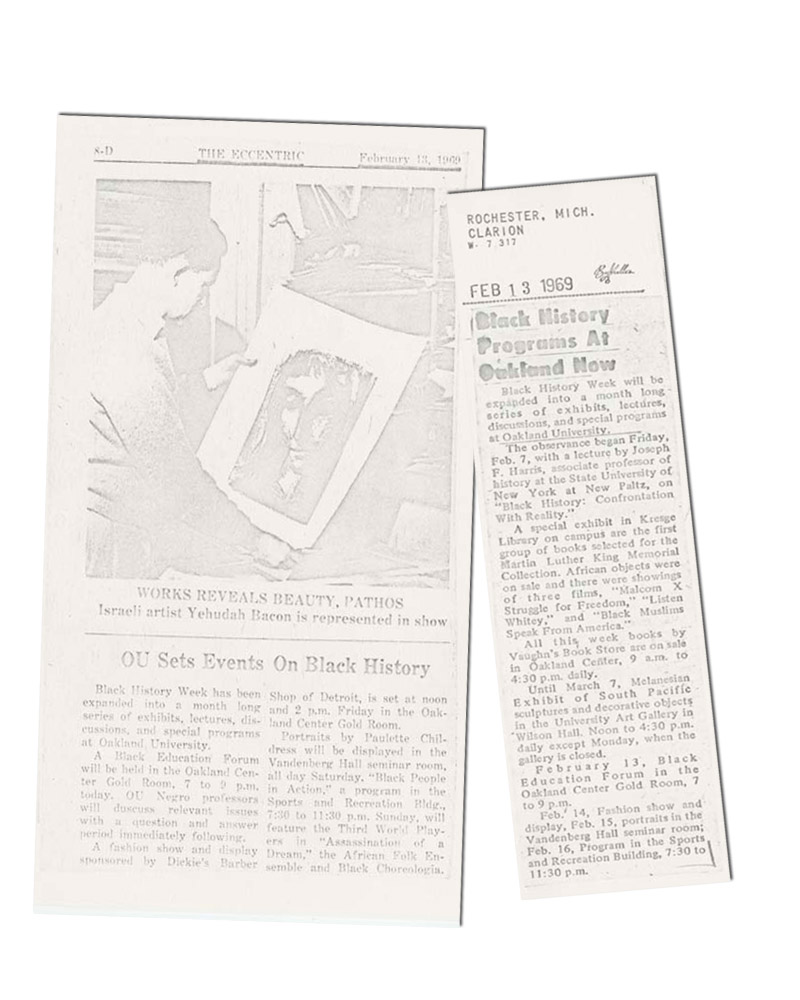 In February 1926, Carter G. Woodson initiates Negro History Week--a recognition of African-Americans' historical contributions (1). By February 1969, Oakland University extends this event to a month-long celebration, seven years before the United States Federal government officially recognizes Black History/ African American Celebration Month (2).
1. Source: Library of Congress, African American History Month: About
2. "OU Sets Events on Black History," news clip from The Eccentric, 13 February 1969
Image: Oakland University Archives
In February 1926, Carter G. Woodson initiates Negro History Week--a recognition of African-Americans' historical contributions (1). By February 1969, Oakland University extends this event to a month-long celebration, seven years before the United States Federal government officially recognizes Black History/ African American Celebration Month (2).
1. Source: Library of Congress, African American History Month: About
2. "OU Sets Events on Black History," news clip from The Eccentric, 13 February 1969
Image: Oakland University Archives
1969: Gender Inequality and Women's Rights at OU
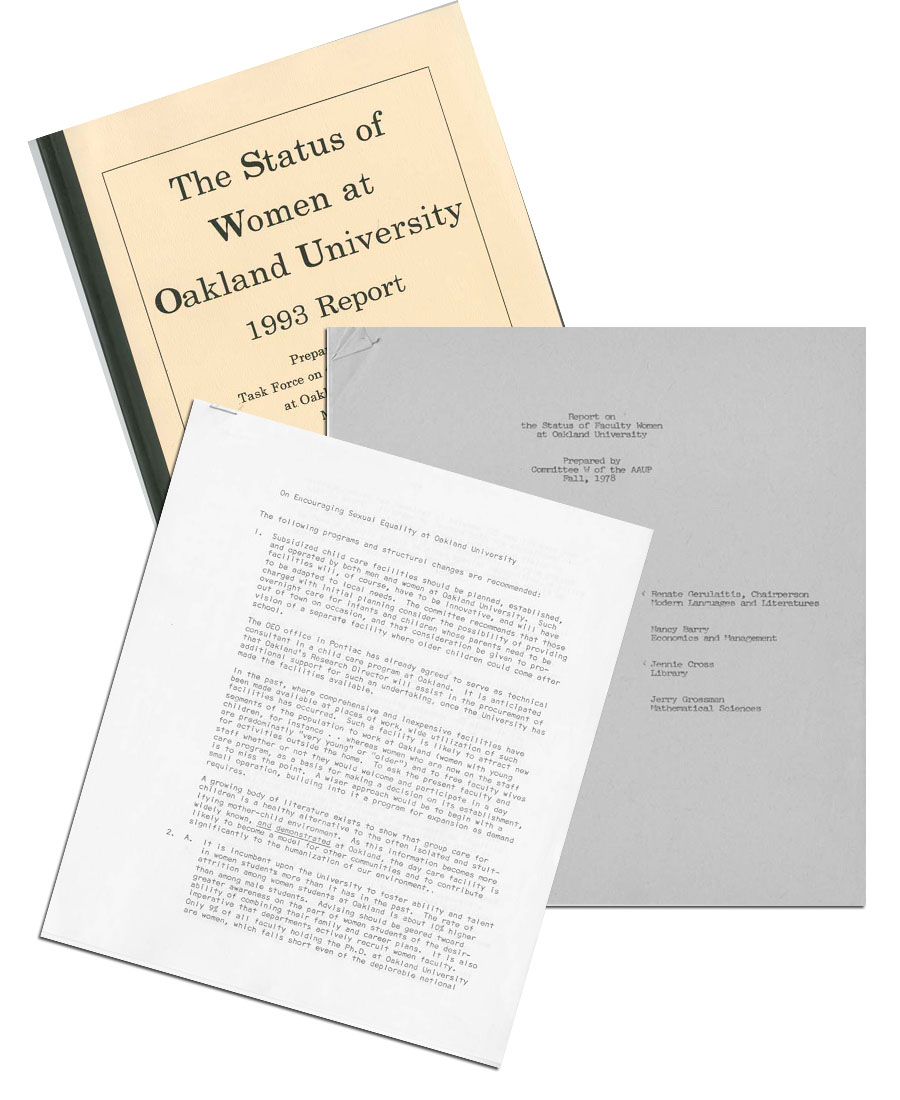 Like its peers, Oakland University has struggled with gender inequality. During the last half-century, the University has produced numerous reports that analyze pay and promotion gaps between male and female faculty and staff. These reports also describe differential achievement levels and opportunities between male and female students.
In 1969, the Women Right's Committee produced "On Encouraging Sexual Equality at Oakland University," a five page document that recommended programmatic and structural changes that would facilitate a more welcoming environment for female students, staff, and faculty. In 1971, the Oakland chapter of the American Association of University Professors produced "Report of the Status of Women at Oakland". This report was updated in 1978. In 1993, the Task Force on the Status of Women at Oakland University issued its own report. Together, these reports illustrate a history of challenges and successes for women at OU.
Image source: Oakland University Archives
Like its peers, Oakland University has struggled with gender inequality. During the last half-century, the University has produced numerous reports that analyze pay and promotion gaps between male and female faculty and staff. These reports also describe differential achievement levels and opportunities between male and female students.
In 1969, the Women Right's Committee produced "On Encouraging Sexual Equality at Oakland University," a five page document that recommended programmatic and structural changes that would facilitate a more welcoming environment for female students, staff, and faculty. In 1971, the Oakland chapter of the American Association of University Professors produced "Report of the Status of Women at Oakland". This report was updated in 1978. In 1993, the Task Force on the Status of Women at Oakland University issued its own report. Together, these reports illustrate a history of challenges and successes for women at OU.
Image source: Oakland University Archives
1970: Black students enrollment
The University Senate votes to increase black enrollment to 15% of the freshman class.Source: Minutes of the Meeting of the University Senate, May 13, 1970
1970: Coed living
In 1970, a proposal was put forward to encourage the creation of some coed living spaces in the existing student dorms. These spaces were planned to only house "hand-picked" students whose parents would know ahead of time they would be living in a co-ed space.1970: International Students and Scholars
 In July, the International Students and Scholars Office is established. As noted on its website, ISSO " is committed to building an international campus through service, support and advocacy to nurture global citizenship and multicultural appreciation."
In July, the International Students and Scholars Office is established. As noted on its website, ISSO " is committed to building an international campus through service, support and advocacy to nurture global citizenship and multicultural appreciation."
Image: OU International Students and Scholars Office
1971: Black Liberation Caucus
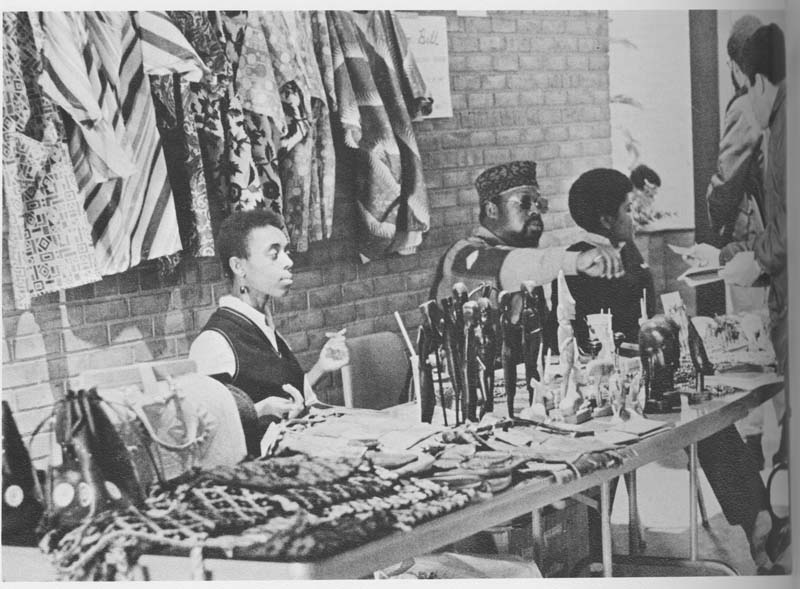 In January, the Black Liberation Caucus is founded. According to the March 15, 1971 edition of OU, an official university newsletter, BLC replaces the Association of Black Students, as the "formal" organization for OU African American students. The article notes that BLC views itself as a "political organization linked with a world-wide liberation movement". In its general policy statement, BLC offers the following political stance:
In January, the Black Liberation Caucus is founded. According to the March 15, 1971 edition of OU, an official university newsletter, BLC replaces the Association of Black Students, as the "formal" organization for OU African American students. The article notes that BLC views itself as a "political organization linked with a world-wide liberation movement". In its general policy statement, BLC offers the following political stance:
The Black Liberation Caucus is dedicated to the liberation of black people and is guided by the principles of black revolutionary nationalism and pan-Africanism. We are committed to a struggle against racism, capitalism, and imperialism both in the U.S. and internationally, especially on the African continent.
According to a James D. Graham essay, "The Revolution Was Not Televised: Perspectives from the Banks of Beer Lake, 1969-1975,"(1) by 1974 BLC morphed into the "more inclusive" student organization: the Association of Black Students. However, a petition for recognition as a student organization indicates that ABS existed since early 1968. (See 1968 entry for Association of Black Students).(1) OU Journal, Issue No. 7, Fall 2004
Image: Oakland University Archives
1971: OU La Raza Day
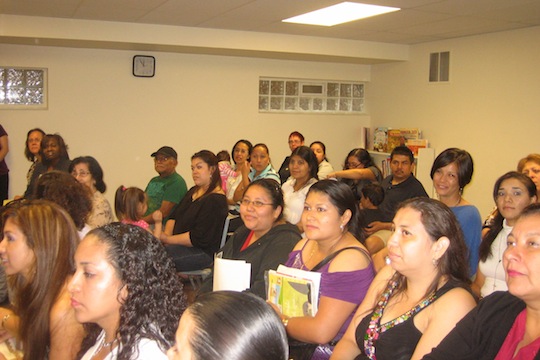 Oakland University Latin-American staff and students, in conjunction with the Admissions Office, sponsors the university's first "La Raza Day". La Raza Day is a campus visitation program, culturally oriented to Latino high school students. The goal of the program is to "promote cultural awareness and to explore the opportunities and facilities available in higher education for...Latino student[s]". The second annual La Raza Day is briefly mentioned in the April 18, 1972 Oakland University Newsletter.
Oakland University Latin-American staff and students, in conjunction with the Admissions Office, sponsors the university's first "La Raza Day". La Raza Day is a campus visitation program, culturally oriented to Latino high school students. The goal of the program is to "promote cultural awareness and to explore the opportunities and facilities available in higher education for...Latino student[s]". The second annual La Raza Day is briefly mentioned in the April 18, 1972 Oakland University Newsletter.
Image: The Hispanic Outreach Program
1974: Afro-American Studies Program
OU starts the Afro-American Studies Program, a concentration to "help students see the history, life, and culture of Afro-Americans from the perspectives of several different academic disciplines. In the memo below, Professor De Witt S. Dykes explains that the program, which requires 28 credits, is suitable to a wide range of students. Afro-Americans Studies (later combined with African Studies Program and renamed African and African American Studies) is currently a minor concentration in the International Studies Program .
Image: Oakland University Archives
.
Image: Oakland University Archives
1974: Black Alumni Association
The OU Black Alumni Association is established in June.1974: Women's Center
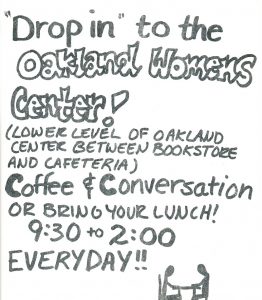
Image source: Women's Center, vertical file, Oakland University Archives
In June of 1974, talk first started about getting a Women's Center on campus. People felt that the center was needed to serve OU women and in the local community as well. There was concern over whether or not the center would be legal under Title IX, but coordinators of the Women's Center assured skeptics that it was. They reassured concerned members of the OU community that there was no desire to exclude men, and said some male students already had interest in the center in the summer of 1974. On July 22, 1974, the official Women's Center Proposal was drafted. The goal was to "serve women, primarily those returning to school after some interruption". The proposal went on to list the variety of services that were to be offered thorough the center: academic advising, counseling, files of resource materials on opportunities for women, and more. The importance of having a facility with all of these support functions was emphasized, as at the time, no other place on campus could fulfill all of the functions that the Women's Center planned to do. By January of 1975, the Women's Center opened in the Oakland Center, and less than a year later it was hosting talks on rape, lectures on sexuality, and film screenings.1981: Black Profiles Booklet
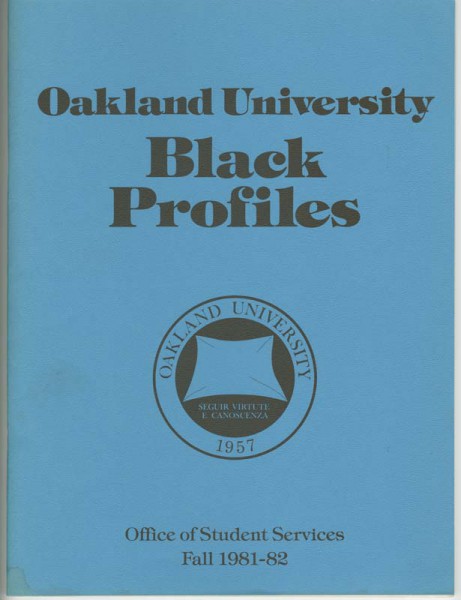 Dean of Students Manuel H. Pierson approves the production of "Oakland University Black Profiles," a booklet of OU African American student leaders, faculty, and staff. Distributed on October 27, 1981, this publication was compiled to facilitate solidarity and academic success within the OU African American student population.
Dean of Students Manuel H. Pierson approves the production of "Oakland University Black Profiles," a booklet of OU African American student leaders, faculty, and staff. Distributed on October 27, 1981, this publication was compiled to facilitate solidarity and academic success within the OU African American student population.
Image: Oakland University Archives
1982: The Women of Oakland University
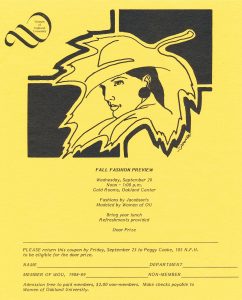
Image source: Women of OU collection, Oakland University Archives
The Women of Oakland University became an organization to replace the University Women's Club. The by-laws of the organization were sent out with the first newsletter. They read in part "The purpose of Women of Oakland shall be 1) to promote a spirit of community among women associated with Oakland University, and 2) to provide service to Oakland University. These purposes shall be effected by offering educational, cultural, service and social opportunities to members of the organization." Members paid dues and were able to become part of smaller subcommittees. These smaller "interest groups" put on events of their own, ranging from aerobics, baby-sitting exchanges, book exchanges, crafts, sports, and forums for women's issues. All meetings for the organization were held at Meadow Brook Hall.1988: Hispanic Heritage Month
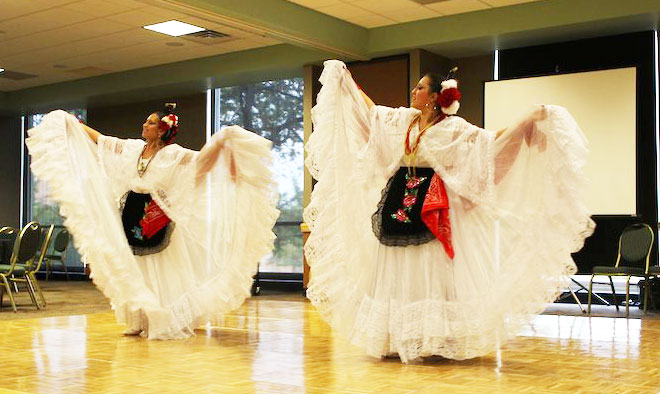 On September 15th, Hispanic Heritage Week is expanded to a month long celebration (see information on the Center for Multicultural Initiatives website). A dance performance from the 2012 OU Hispanic Heritage Month is featured above.
On September 15th, Hispanic Heritage Week is expanded to a month long celebration (see information on the Center for Multicultural Initiatives website). A dance performance from the 2012 OU Hispanic Heritage Month is featured above.
Image: Hispanic Celebration Month
1989: OU Affirmative Action
According to the May 10th Board of Trustees Meeting minutes, Dr. John De Carlo, Vice President of Government Affairs, motioned the Board to approve an affirmative action policy that would facilitate diversity among the University's staff and faculty. The motion was approved.1990: Mission: Unity
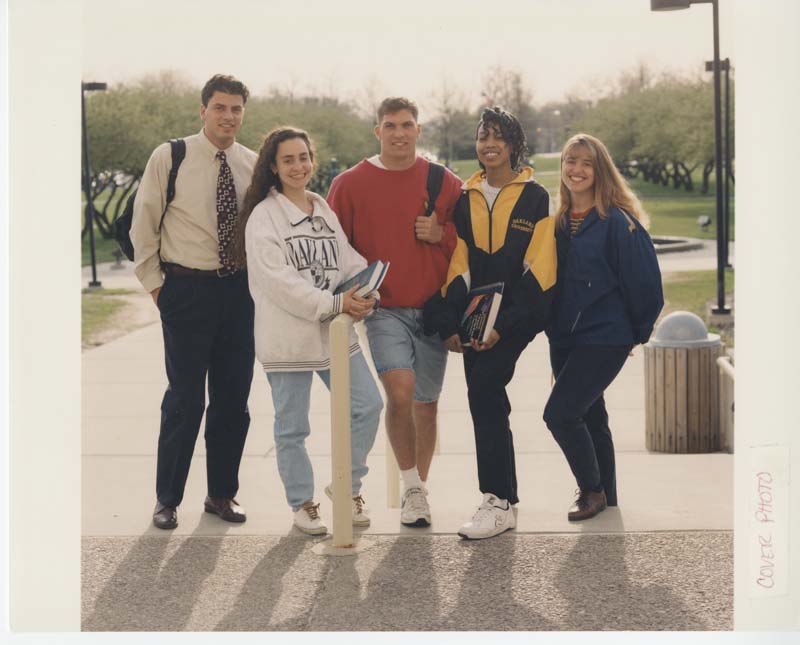 Mission: Unity, consisting of students, staff, faculty, and alumni, is formed to facilitate cross-cultural discussions about race. Marc Allen Payne, a senior, is its founding president. The organization is later renamed Cross-roads. (11 July 1990 Board of Trustees minutes).
Mission: Unity, consisting of students, staff, faculty, and alumni, is formed to facilitate cross-cultural discussions about race. Marc Allen Payne, a senior, is its founding president. The organization is later renamed Cross-roads. (11 July 1990 Board of Trustees minutes).
Image: Oakland University Archives
1992: Origins of the Center for Multicultural Initiatives
 Approximately 150 African-American students conduct a sit-in at President Sandra Packard's office, in protest of lack of an office for minority affairs. This action results in the creation of an Office for Minority Equity a year later. Glenn McIntosh is appointed Director In January 1994 (OU Senate Minutes, January 13, 1994).
OME is later renamed the Center for Multicultural Initiatives.
Approximately 150 African-American students conduct a sit-in at President Sandra Packard's office, in protest of lack of an office for minority affairs. This action results in the creation of an Office for Minority Equity a year later. Glenn McIntosh is appointed Director In January 1994 (OU Senate Minutes, January 13, 1994).
OME is later renamed the Center for Multicultural Initiatives.
Image: Oakland University Archives
1993: Keeper of the Dream Scholarship Award
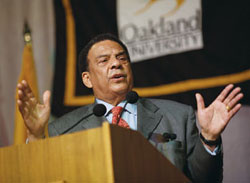 In January, the OU Center for Multicultural Initiative establishes the Keeper of the Dream Scholarship Award. In honor of Dr. Martin Luther King, Jr., several scholarships are awarded annually to OU students "who have contributed to interracial understanding and good will".
In January, the OU Center for Multicultural Initiative establishes the Keeper of the Dream Scholarship Award. In honor of Dr. Martin Luther King, Jr., several scholarships are awarded annually to OU students "who have contributed to interracial understanding and good will".
Image: Andrew Young, Keynote Speaker, 2006 Keeper of the Dream Scholarship Banquet
1993: Manuel Pierson Diversity Statement
During the September 30, 1993 OU Senate meeting, Dr. Manuel Pierson presents findings about ethnic diversity at the University. As noted in the minutes, Dr. Pierson "stressed the importance of recognizing diversity and encouraging respect for different cultures, traditions, and viewpoints within Oakland University as well as in the broader society. "1993: Office of Inclusion and Intercultural Initiatives

Image source: Oakland University Archives
Originally housed within the Office for Minority Equity, the Office of Inclusion and Intercultural Initiatives "serves as a resource and is charged with promoting and furthering the university's commitment to the principles of diversity inclusion and equal opportunity." The Office is linked to several diversity and inclusion initiatives: Presidential Diversity Award, Employee Resource Groups (ERG), and ADVANCE: WISE@OU. The above picture features several international students from an early 1960s "foreign student tea." From left to right: Angelique Sherman (Liberia), Mary Finkelstein (Cuba), Elizabeth Davis (Liberia), Wolfe Metzger (Austria). Director of Admissions Herbert Stoutenburg (standing, far right) and Mrs. Stoutenburg (seated, far right) host the group.2003: SAFE Program for OU LGBTQIA Community
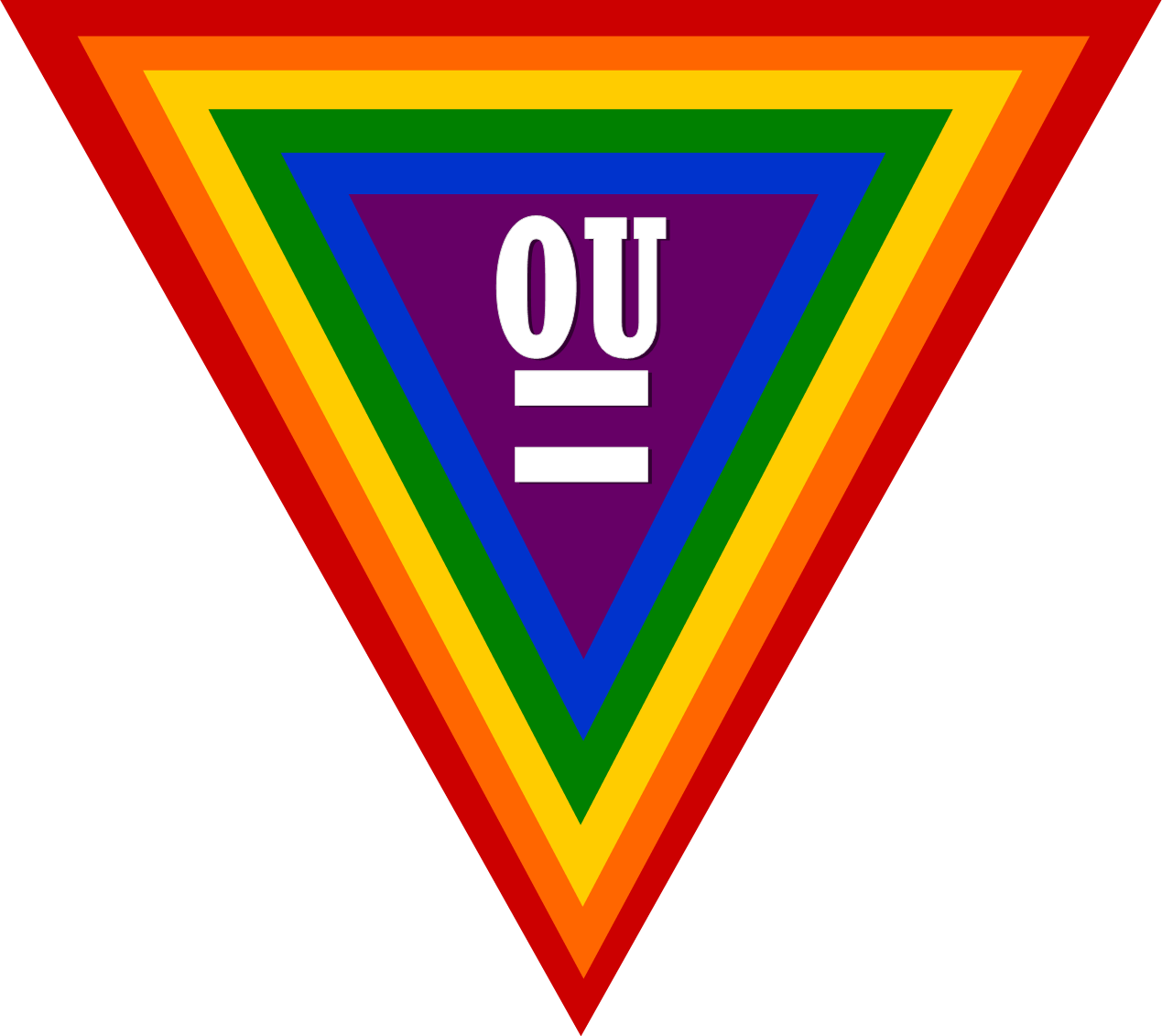 S.A.F.E. (Students, Administration, and Faculty for Equality) is established. According to the October 23, 2003 campus news release, SAFE is "a new organization committed to providing an open and supportive environment for the lesbian, gay, bisexual and transgender (LGBT) campus community. Program participants, or "allies," are available for assistance and also help challenge homophobia, heterosexism and other forms of discrimination".
S.A.F.E. (Students, Administration, and Faculty for Equality) is established. According to the October 23, 2003 campus news release, SAFE is "a new organization committed to providing an open and supportive environment for the lesbian, gay, bisexual and transgender (LGBT) campus community. Program participants, or "allies," are available for assistance and also help challenge homophobia, heterosexism and other forms of discrimination".
Image: SAFE
2004: LGBTQIA Employee Resource Group
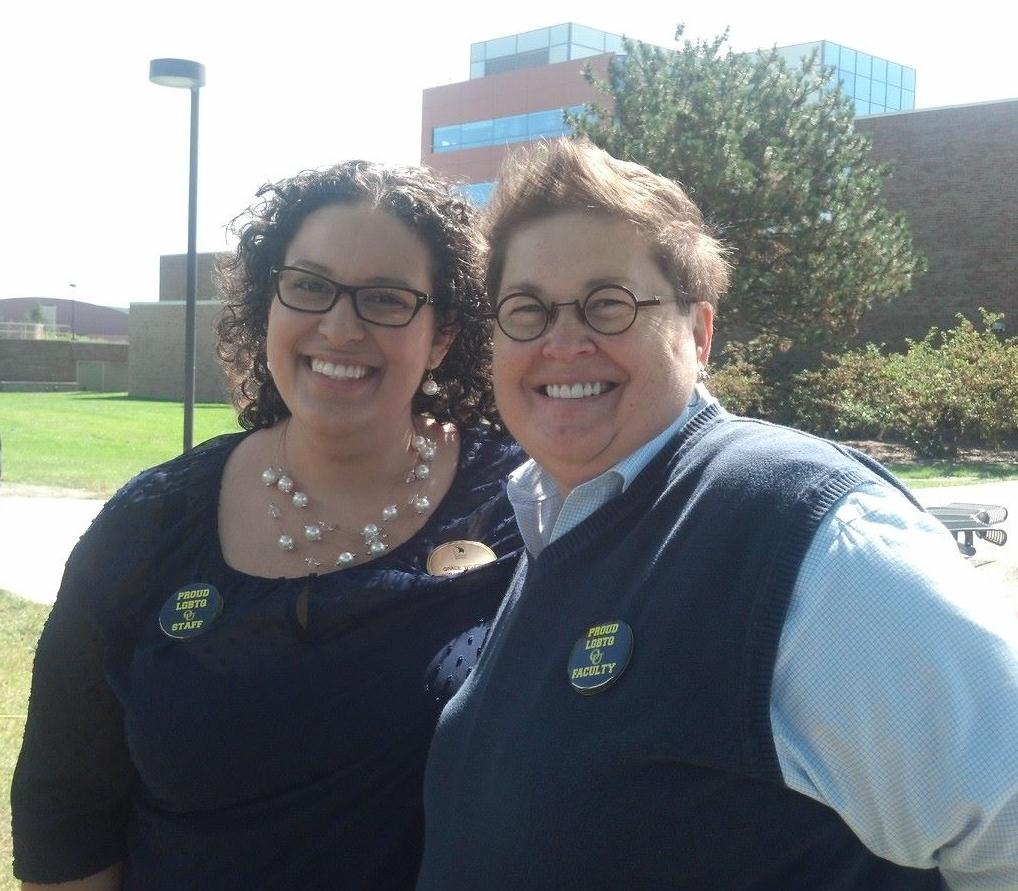 OU employees establish the Lesbian, Gay, Bisexual, Transgender, Queer, Intersex, and Ally Employee Resource Group (LGBTQIA). The group's mission is to " to foster an inclusive, open campus community, and to advance equality for lesbian, gay, bisexual, transgender, queer/questioning, intersex and allied people." LGBTQIA notes that its mission also "support[s] the diversity and full inclusion and achievements of [the OU] student body."
OU employees establish the Lesbian, Gay, Bisexual, Transgender, Queer, Intersex, and Ally Employee Resource Group (LGBTQIA). The group's mission is to " to foster an inclusive, open campus community, and to advance equality for lesbian, gay, bisexual, transgender, queer/questioning, intersex and allied people." LGBTQIA notes that its mission also "support[s] the diversity and full inclusion and achievements of [the OU] student body."
Image: LGBTQIA Employee Resource Group
2006: Asian-American Celebration
 From January 30 to February 3, OU holds its first Asian-American Celebration to recognize the uniqueness of cultures that "fall within the boundaries of Asia," including Russia, Pakistan, India, and Afghanistan.
From January 30 to February 3, OU holds its first Asian-American Celebration to recognize the uniqueness of cultures that "fall within the boundaries of Asia," including Russia, Pakistan, India, and Afghanistan.
Image: Oakland University Archives
2006: Native American Student Association
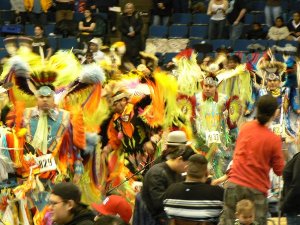 The OU Native American Student Association is founded to "increase awareness on campus about the culture and heritage of Native Americans". For more recent information, see Student Aspires to Work for Native American Rights.
The OU Native American Student Association is founded to "increase awareness on campus about the culture and heritage of Native Americans". For more recent information, see Student Aspires to Work for Native American Rights.
Image: Student Aspires to Work for Native American Rights
2011: CMI C.O.R.E. Summer Bridge Program
 A diversity initiative headed by the Center for Multicultural Initiatives, Collectively Oakland Retains Everyone (C.O.R.E.) Summer Bridge Program is a free, week-long residential experience on campus, designed to help new students bridge the gap between high school and college, while building relationships and honing academic skills. The Bridge Program is the first step in helping first year working-class and other minority students succeed at Oakland University. After the Summer Bridge Program, CORE students meet with mentors weekly to facilitate academic progress. They are also required to live on campus during their first year.
A diversity initiative headed by the Center for Multicultural Initiatives, Collectively Oakland Retains Everyone (C.O.R.E.) Summer Bridge Program is a free, week-long residential experience on campus, designed to help new students bridge the gap between high school and college, while building relationships and honing academic skills. The Bridge Program is the first step in helping first year working-class and other minority students succeed at Oakland University. After the Summer Bridge Program, CORE students meet with mentors weekly to facilitate academic progress. They are also required to live on campus during their first year.
Image: CORE
2011: Women in Science and Engineering at Oakland (WISE@OU)
 In September, National Science Foundation (NSF) awards Oakland University a four-year, $519,000 ADVANCE grant to increase the number of women and underrepresented minorities in the STEM fields.
According to the program's website, W.I.S.E. has four institutional goals:
In September, National Science Foundation (NSF) awards Oakland University a four-year, $519,000 ADVANCE grant to increase the number of women and underrepresented minorities in the STEM fields.
According to the program's website, W.I.S.E. has four institutional goals:
- Increase diversity of search pools
- Ensure that an increased percentage of new STEM tenure-track faculty are women or are from under-represented populations
- Ensure that an increased percentage of tenured STEM faculty are women or are from under-represented populations
- Ensure that each academic unit has a percentage of women or under-represented populations at full professor level
2012: OU Female Engineering Faculty
 For fall 2012, the American Society for Engineering Education ranks Oakland University 4th in the country for percentage of women tenure-track/ tenured faculty in engineering. See "Engineering by the Numbers" (p.30).
Image: WISE@OU
For fall 2012, the American Society for Engineering Education ranks Oakland University 4th in the country for percentage of women tenure-track/ tenured faculty in engineering. See "Engineering by the Numbers" (p.30).
Image: WISE@OU
2013: OU Minority Enrollment 2013
The OU Office of Institutional Research and Assessment reports a minority student population of 4,012 in its Fall 2013 headcount. This represents roughly 21% of the total student population. This number does not include possible minorities among the 1,013 unreported students.- African American = 1, 768
- Asian/Pacific Islander =1,010
- Hispanic = 528
- Native American = 188
- Foreign Nationality = 486
2013: Women as Majority of OU Student Population
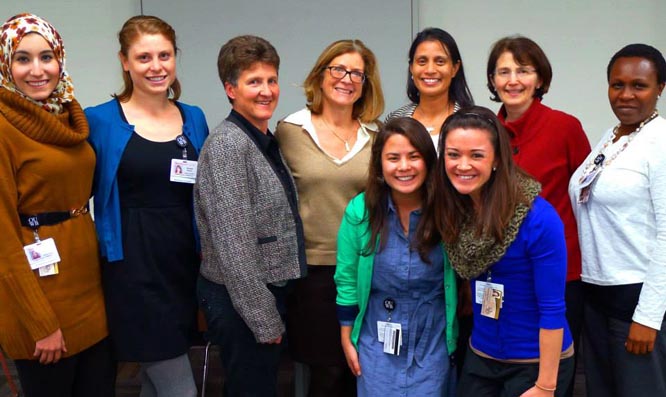 According to the OU Office of Institutional Research and Assessment, 20,169 students enrolled in the fall 2013 semester. Approximately 66% are women. This percentage seems to reflect gender enrollment statistics compiled by the National Center for Educational Statistics.
According to the OU Office of Institutional Research and Assessment, 20,169 students enrolled in the fall 2013 semester. Approximately 66% are women. This percentage seems to reflect gender enrollment statistics compiled by the National Center for Educational Statistics.
Undergraduate students
- Male: 6,820
- Female: 9,774
Graduate students
- Male: 1,412
- Female: 2,163
Photos courtesy of the Oakland University Archives.